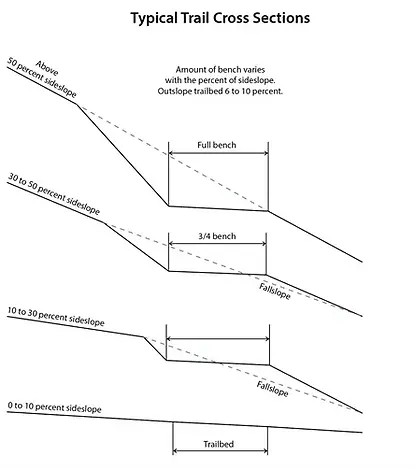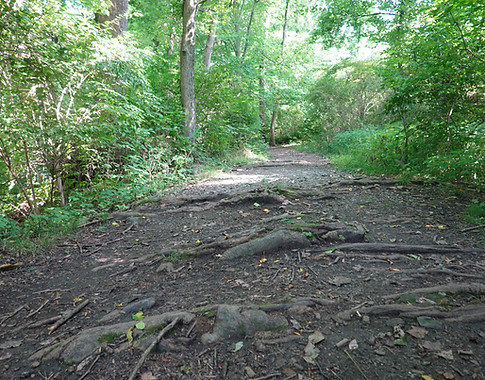ASCENT - Trail Stress
Features that make it difficult or impossible for those with disabilities to complete a trail
TO RECAP
Trail Stress refers to features of the trail (e.g., its cross-grades, width obstacles, and surface) that make a person with a disability uncomfortable (Stressors) OR force them to abandon their walk (Barriers).
-
Whether a characteristic is a stressor or barrier depends largely on the nature of the person's disability, but also on skills and confidence they might have gained through walking other trails.
Our grade ratings are based on the Universal Access (UA) Standards - we link to specific pages wherever possible.
We include ideas about improvements to natural trails to address sources of Trail Stress but always recommend you work with an experienced trail designer.
Read more about Trail Stress HERE

Trail Barriers
The ADA and related legislation primarily on identifying removing barriers that prevent a person with a disability from enjoying a facility and/or program. Listed below are examples of barriers encountered on paths and trails that will prevent some people (depending on the nature of their disability) from enjoying a walk in a park of preserve.
Examples (Click to advance photos)


Describe your image


Trail Stressors
Unlike barriers that might prevent people with disabilities from continuing their walk, other features are sources of stress that people with disabilities might find challenging but not impossible to overcome depending on their strength, skills and/or experience. Nonetheless, enough stressors can accumulate so as to make a walk so uncomfortable that the person may choose to abandon it.
-
Our Rating System captures not only the presence of sections with features that can represent a trail barrier or stressor, but how long the section is, and whether that feature occurs in isolation or with other possible stressors... This can help a walker gauge the combined effects of stressors on their comfort.
Examples (Click play to advance photos)


Describe your image

Tread Surface
DEFINITION Is the trail surface:
-
Clear - Can you see where the surface is within 1-2 inches?
-
Firm - Do you sink into the surface?
-
Stable Does the surface remain consistent regardless of the weather?
WHY IS THIS IMPORTANT? Sections with a surface that is not clear, firm, and stable can be a source of stress if not a barrier, depending on the person's disability.
-
A soft section of trail becomes a barrier to a wheelchair user who sinks in and cannot get out, but a source of stress for a parent pushing a small-wheeled stroller.
-
A soft or slippery section becomes a source of stress for a user with poor balance worried about falling.
RATINGS
-
A+ Asphalt, concrete, or boardwalk - the Standard for Shared Use Paths (Trails for All People, p. 69)
-
A Gravel surface that is clear, firm, and stable - the Standard for UA Trails (Trails for All People, p. 31)
-
A- Grass or dirt surface that is:
-
(a) clear;
-
(b) generally firm - e.g., a footprint will not have than a 1/2" rim and a 2" wide wheel will not leave a rut more than 1" deep), and;
-
(c) generally stable - e.g., except after exceptionally prolonged or significant rainfall
-
-
B Grass or dirt surface that includes softer sections: e.g., a foot may sink up to 1/2-1" deep or a bicycle / wheelchair / stroller wheel might sink 1-2" deep
-
C Falls short of the criteria above

The Prickly Pear Trail near Delaware's beaches is a beautiful walk through the sea pines. It includes an option to return on a section that is hard-packed and would be rated A EXCEPT for 2 short stretches that are all sand, into which Margot's special needs trailer quickly sank almost 2 inches, meriting a B rating.

This floating boardwalk on a Martha's Vineyard trail ingeniously connects a natural trail to the seaside EXCEPT when it comes loose to reveal gaps
POTENTIAL SOLUTIONS
As always, solutions for natural surface trails are much easier to implement than for paved paths, as are potential problems identified during the initial design process
-
Planning a route for a natural trail that stays above the lowest point can prevent soggy sections
-
Sometimes a short section of culvert diverting the run-off can prevent trails from becoming soggy
-
Longer sections of turnpike or boardwalk may sometimes be needed.
-
Gravel paths might lose their firmness because they become too saturated, were not sufficiently compacted when first installed, or because they were not constructed with the recommended mix - Trail Surface Aggregate (Trails for All People, p. 24)
More examples of tread surface and possible solutions (Click to advance photos)


Describe your image


Cross Grades
DEFINITION A slope perpendicular to the direction of travel such that you feel like your are tilted sideways.
WHY IS THIS IMPORTANT? Sections with increased Cross-Grades can create barriers or stress
-
Wheelchair users may need to correct their route to prevent drifting off of the path when faced with cross-grades greater than 5%
-
Those with poor balance may struggle to readjust when Cross Grades exceed 10%, especially if these more extreme cross-grades occur together with other stressors (obstacles, a slippery surface, and so on)

Wheelchair users might find sections of the Pocopson Park Path with 5-10% cross grades that merit an A- rating to be stressful.
RATINGS
-
A+ 2% maximum Cross Grades - the Standard for Shared Use Paths (Trails for All People, p. 68)
-
A 5% maximum Cross Grades - the Standard for UA Trails (Trails for All People, p. 30)
-
A- 5-10% maximum Cross Grades
-
B 10-15% Cross-Grades
-
C Greater than 15% Cross-Grades
POTENTIAL SOLUTIONS
As always, solutions for natural trails are much easier to implement than for paved paths, as are potential problems identified during the initial design process
-
When the route runs perpendicular to the slope of up to 10%, re-routing the path up or downslope up to 45 degrees can create cross- and running grades that are more manageable
-
When a route traverses a slope greater than 10%, a bench cut (see right from IMBA-Europe) can create a more manageable cross-slope
-
When using a bench cut, remember to plan for the flow of runoff that risks eroding your new route

More examples of cross-grades and possible solutions (click to advance photos)


Obstacles
DEFINITION Anything that protrudes above the surface of a path or trail across the width of the path or trail that a walker cannot simply step around but must step over
WHY IS THIS IMPORTANT? Obstacles can cause stress or create barriers.
-
A 3" high root across the width of the trail can create stress for someone with poor balance who is worried that they might trip over it.
-
Two roots that are each 1 1/2" high, that stretch across the width of the trail, and that are separated by less than 48" can create a barrier for someone using a wheelchair who can become trapped in between them
-
Note that obstacles are ignored on Walking Paths and Trails if there is a 36" wide path around them (or 32" wide for a short section)

Walkers risk tripping on this section of the PennDel Trail with roots up to 2" high that extend across the width of the trail without a 48" gap, meriting an A- Rating.
RATINGS
-
A+ Maximum 1/2" high on asphalt, or concrete paths and boardwalks - the Standard for Shared Use Paths (Trails for All People, p. 69)
-
A No more than 2" high on stone dust or natural surface trails - the Standard for UA Trails (Trails for All People, p. 33)
-
A- Obstacles across the width of the trail that are
-
Up to 3" high OR
-
1-2" high but separated by less than 48"
-
-
B Obstacles across the width of the trail that are
-
Up to 6" high OR
-
2-4" high but separated by less than 48"
-
-
C Obstacles that exceed a B rating
POTENTIAL SOLUTIONS
As always, solutions for natural surface trails are much easier to implement than for paved paths, as are potential problems identified during the initial design process
-
Isolated rocks/roots might simply be cut or dug out.
-
Shorter sections might just require building up the trail around the obstacle with a grass or dirt "ramp"
-
Longer sections might merit a short section of turnpike or boardwalk
-
In some cases, rocks or roots emerge because of erosion, in which case proper drainage must first be ensured before other solutions are implemented
More examples of obstacles and possible solutions (Click to advance photos)



Describe your image

Tread Width
DEFINITION The width of the trail at its surface.
WHY IS THIS IMPORTANT? Narrow sections can cause stress or create barriers
-
A trail less than 3' wide can create stress for a person with a disability who needs to lean on a friend's arm for support and may find the 3' width too narrow
-
A wheelchair user needs 36" to comfortably navigate, though they can pass through a specific opening as little as 32" wide if needed (see below). A gap less than 32" wide becomes a barrier than forces the wheelchair user to turn around.
The Whitely Farm Loop in White Clay Creek State Park (a 3' wide walking path) sometimes narrows by 1-2 inches to barely allow Margot's 32" wide special needs trailer to squeeze through, still meriting an A Rating.

RATINGS
-
A+ 10' - the Standard for Shared Use Paths (Trails for All People, p. 68)
-
A At least 3-5' - if less than 5', must have Passing Spaces at least every 1000'. Width can also decrease to 32" for up to 24" to pass an obstacle. These are the Standard for UA Trails (Trails for All People, p. 31).
-
A- 3' wide, without Passing Spaces separated by less than 1000'
-
B 18"-3' wide
-
C Less than 18" wide .
POTENTIAL SOLUTIONS
As always, solutions for natural surface trails are much easier to implement than for paved paths, as are potential problems identified during the initial design process
-
Re-routing the route to avoid pinch-points between trees or other obstacles is key
More examples of tread width and possible solutions (Click to advance photos)



Describe your image




